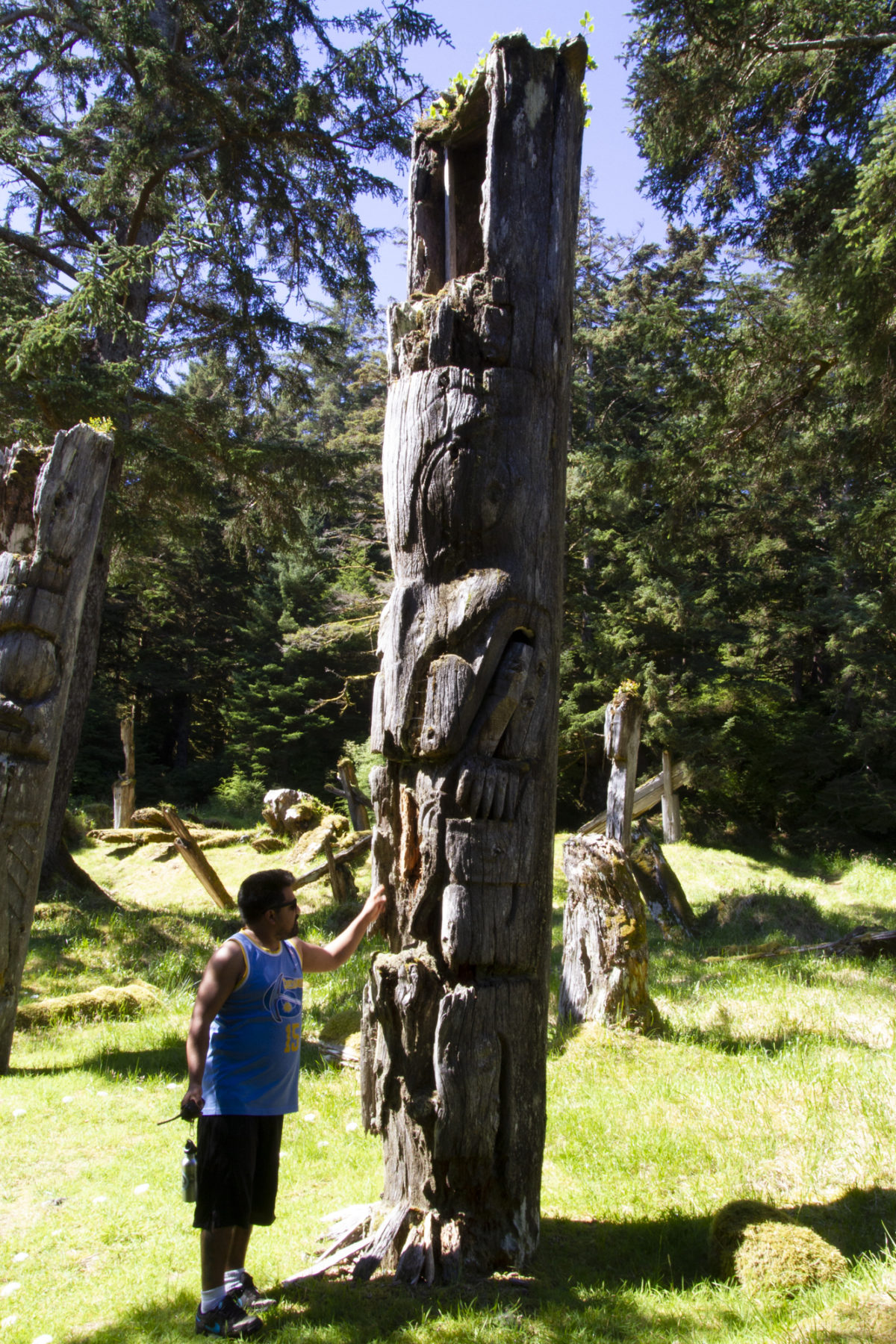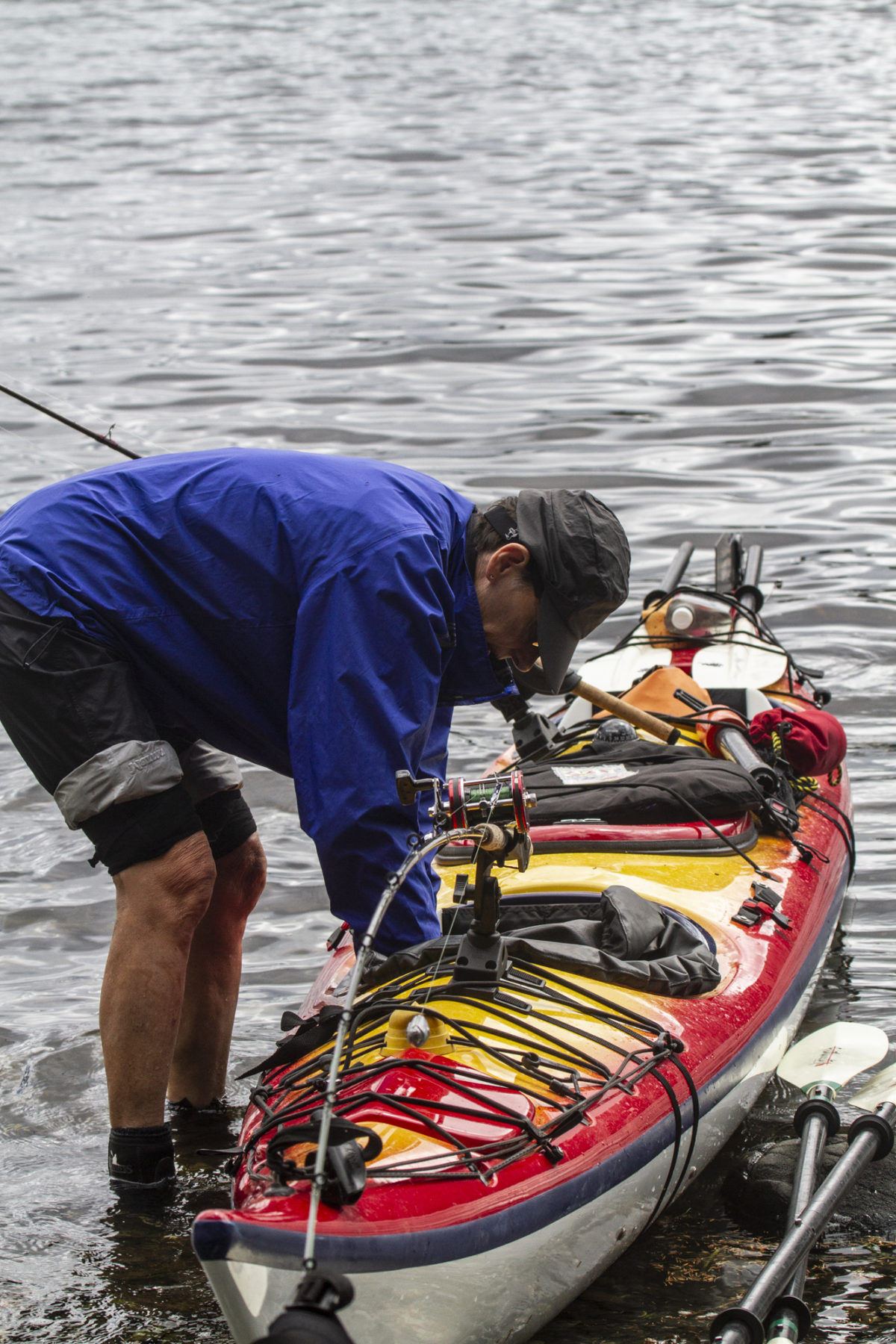A small part of a very big world
Sitting in a sea kayak measuring around five metres in length and knowing one of the world’s largest mammals – a humpback whale – was fishing nearby, with little concern or regard for the nearby kayakers, should have imbued me with a sense of fragility. It didn’t. Instead, it was a sense of feeling like I had become a very small part of this marine giant’s world, Haida Gwaii, an archipelago roughly 100km off British Columbia’s (BC) northern coast that is saturated in wildlife, a unique rugged beauty, and Haida Nation culture and history.
Marine wonderland
Haida Gwaii comprises more than 200 mostly uninhabited islands of various sizes around 50km south of Alaska, and 100km off the BC coast, and it cops the brunt of the powerful Pacific Ocean’s tumultuous weather and tides. Inhabiting the islands and their surrounding waters is a plethora of wildlife, including whales, orca, dolphins and myriad fish species, including the ubiquitous salmon. Onshore you will find a huge number of seabird colonies, plenty of bald eagles and other raptors, and, yep, bears. In fact, the biggest black bears recorded reside here.
There are a number of theories as to why the island bears are so big, including the fact there are no competitors (read: no grizzly bears). Another suggests because the islands don’t cop a “real winter”, the bears do not need to hibernate, thus don’t lose weight over winter. And there’s ample food for them, ranging from shellfish and seaweed washed ashore, through to deer, berries and seasonal salmon.
The islands are also the homeland of the Haida people and contain a number of historical sites, including the UNESCO World Heritage Site of Ninstints (SGang Gwaay Linagaay) that was part of our Kingfisher Wilderness Adventures Burnaby to Ninstints expedition, and something I was really pumped to explore. Add in the fact the islands are also known as Canada’s Galapagos, owing to their isolation from the mainland and the resultant abundance of unique wildlife (an estimated 39 subspecies of animals and plants found nowhere else in the world), and it’s easy to see why a trip here had been near the top of my paddling bucket list for quite a few years.
An unexpected history lesson
I never envisaged starting a sea kayak expedition drifting in a Zodiac in howling wind and rain. For me, and the rest of the group tackling this eight-day tour, it was something that just never crossed our minds. Even though the situation could have been perceived as dire, we were all very calm while waiting for our Zodiac pilot, Grace, to return with a new engine. She had earlier picked us up from Sandspit for the trip down to Kat Island camp. The upside for our group – a mix of Canadians (Gary, Sue and Anne, plus one of our two guides, Silke), South Africans (Andy and Corinna) and one Australian (that’d be me) – was a visit to nearby Tanu Island and the Haida Watchmen’s hut as we awaited Grace’s return.
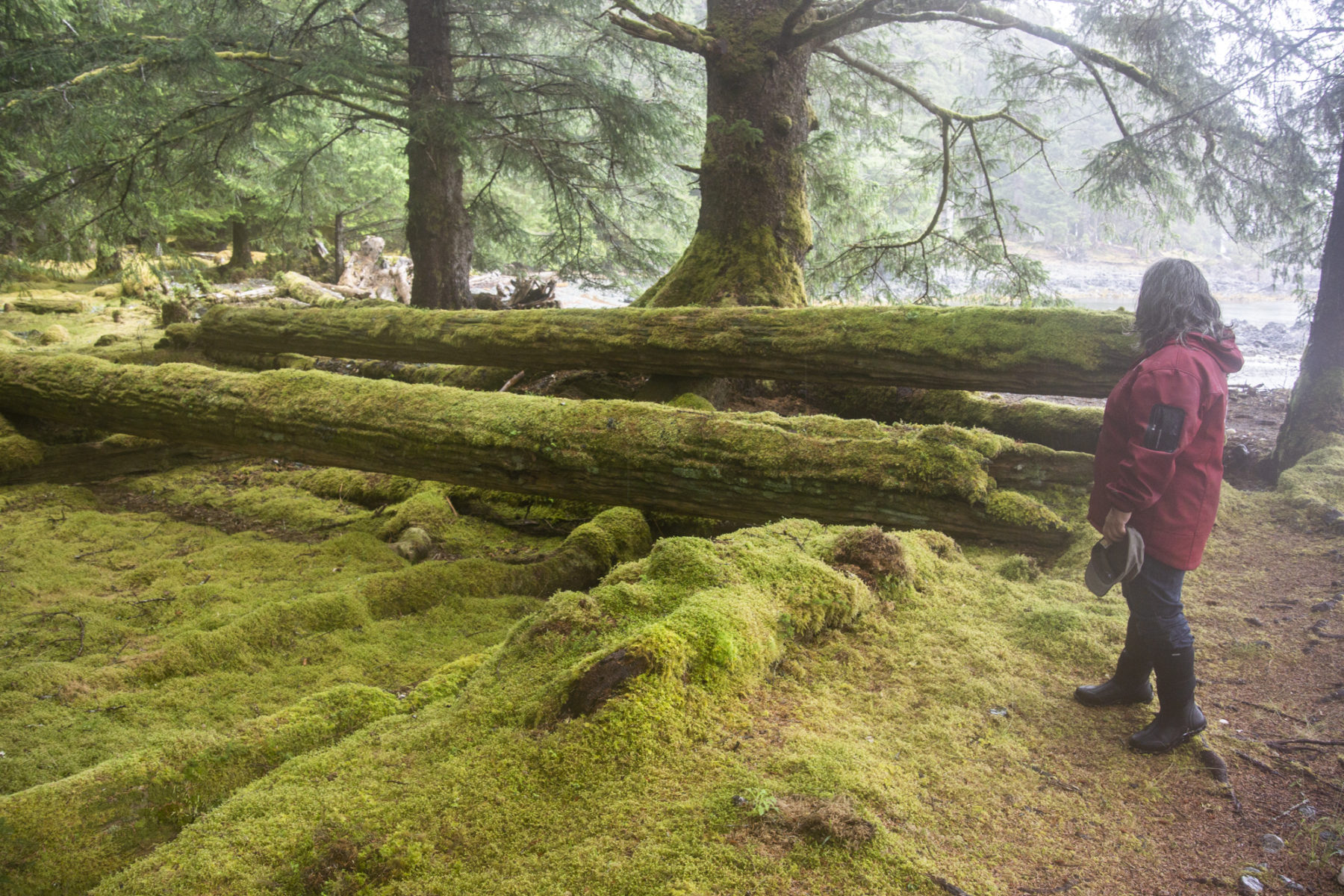
T’aanu Llnagaay (Tanu) is one of Haida Gwaii’s main historical sites, containing the remains of a Haida village. Originally, this village comprised more than 25 long houses, but now there are only some posts, beams and rectangular pits to remind us of what had stood long before. The two Haida on Watchmen duty, Mary and Walter, were gracious enough to provide us with an impromptu tour of the village site on our way to their hut. On top of that, they fed and entertained us for the couple of hours it took for Grace to return. They were more than happy to explain some of their duties as Watchmen, and to recount stories of when they were growing up in the region. It was a brilliant diversion from our original planned route. Unsurprisingly, it was hard to leave their warm hut – and the awesome hospitality – after Grace returned.
The first of the extraordinary
Returning to the Zodiac we were met with more inclement weather and choppier seas, and we bounced our way south to Kat Island and our first camp. It was wet and cold but great fun, and before we knew it Kat Island camp appeared through the rain. As soon as we landed, and met Beth Anne, our second guide, we set about unpacking the numerous boxes of food and supplies for our eight days on the water. It seemed there was a truckload of “stuff”, but both our guides assured us it’d all fit in. Waiting for us were our kayaks (a mix of singles and doubles; Gary and Sue had brought their own custom Kevlar jobbie, of which we were all jealous) and a well-sheltered kitchen area. It had been an exhilarating day; my Therm-a-Rest had never felt so comfortable as when I went to bed that night. It was still raining outside my tent, but in this remote campsite I felt a world away from the everyday – a feeling that would grow on a daily basis…
It took no more than five minutes. After a morning of packing food and gear into kayaks (yes, all that “stuff” did indeed fit) we hit the water at around 11am, only to stop the aforementioned five minutes later when we spotted a black bear fossicking on the far shore of the bay. The clarity of air here made it difficult to judge how far away it was but Anne and I, long zoom lenses at the ready, paddled slowly towards it. We sat their firing away on our cameras for a good 10 minutes before the bear bothered to notice us and move back up into the forest. Its seeming disregard for our presence would become a theme of our wildlife encounters on the trip; I don’t know if I was dreaming it, but there are so few human visitors to the area that local wildlife pretty much ignore bipedal visitors.
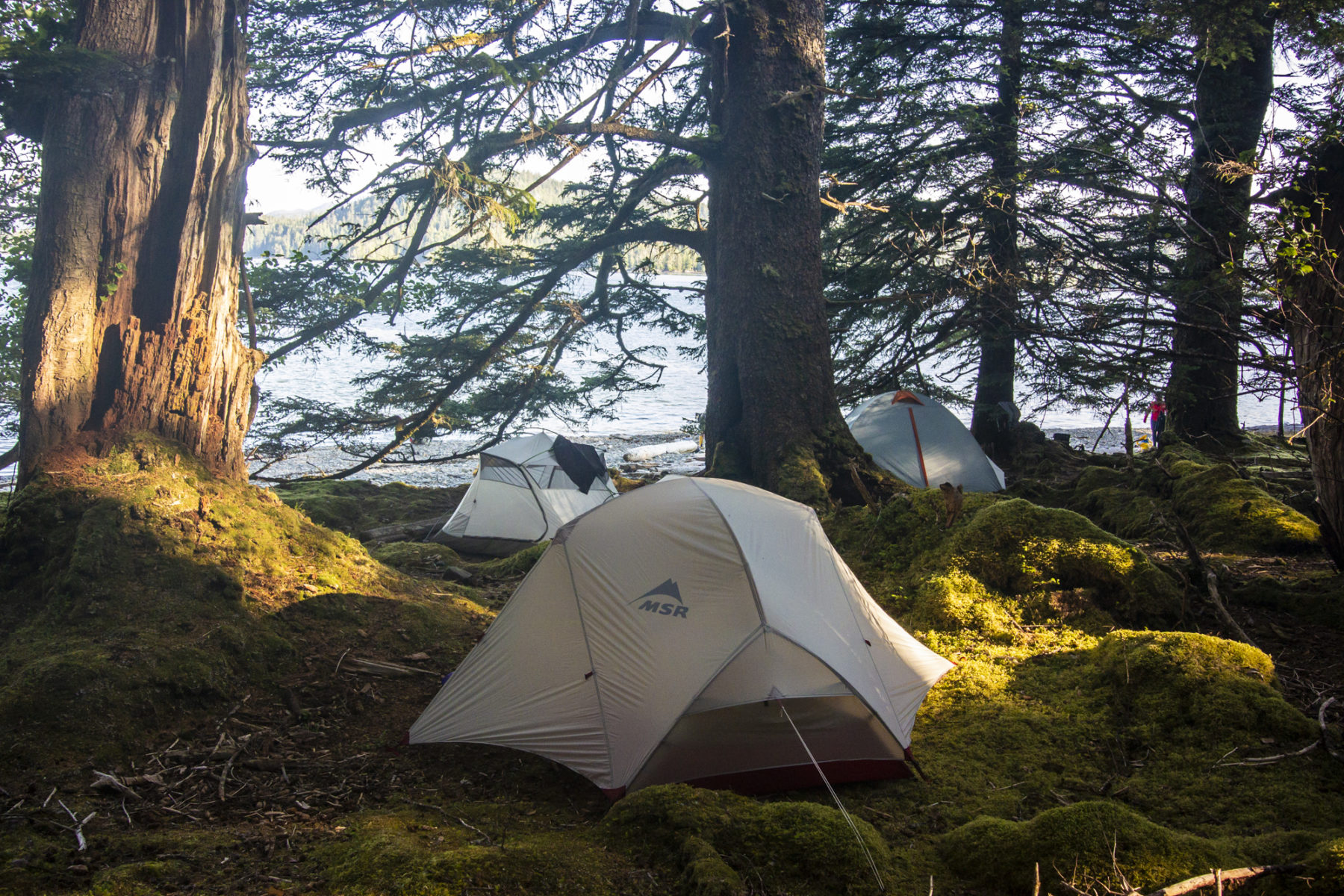
We spotted plenty of salmon as we paddled through the Burnaby Narrows later that morning; Gary was champing at the bit to throw in a line (he and Sue had brought fishing gear) but had to wait until we cleared the Narrows (fishing is not permitted there) before he could chance his luck. As it turned out, patience was a virtue. Gary only had his line in for about 10 minutes before snaring his first salmon – a huge (at least 4kg, I reckon) one that was actually too big to get into the kayak, so he let it go. It was amazing – that fish could have been a meal for all of us for the second night – but it was still nice to see it swim off to continue its migratory journey up one of the islands’ many salmon streams. Gary’s virtuous release was repaid later that same evening: as we rounded the bottom of Burnaby Island and turned north to our Swan Bay campsite, he caught another fish.
There’s nothing quite like relaxing after a day’s paddling and enjoying fresh fish cooked over a campfire that sits right on a beach, looking out over the sea. I was only two days in and Haida Gwaii had already become my new definition of “paddler’s heaven”.
A long way away
I have visited British Columbia on a number of occasions and love the place, but am always braced for its volatile weather, even in summer. So, I was more than stoked to experience two days of sublime, sunny conditions as we continued our journey south. After leaving Swan Bay and crossing the glassy, flat waters of Skincuttle Inlet, we cut through a gap in the Bolkus Islands before rounding Deluge Point and moving into more open water past nearby Ikeda Point on the eastern side of the island group. The paddling was brilliant, with a steady pace only interrupted when we were mock-dived by a bald eagle. We’d seen the adult and juvenile eagles on a rocky outcrop just inland from the point and were guessing the adult was either showing the juvenile how to fish or was, just like the bear, not bothered about us being there – until our kayaks got in the way. Either way, it was a spectacular sight as the eagle flew in, tucked in its wings and bombed the water right in front of Gary and Sue’s kayak.
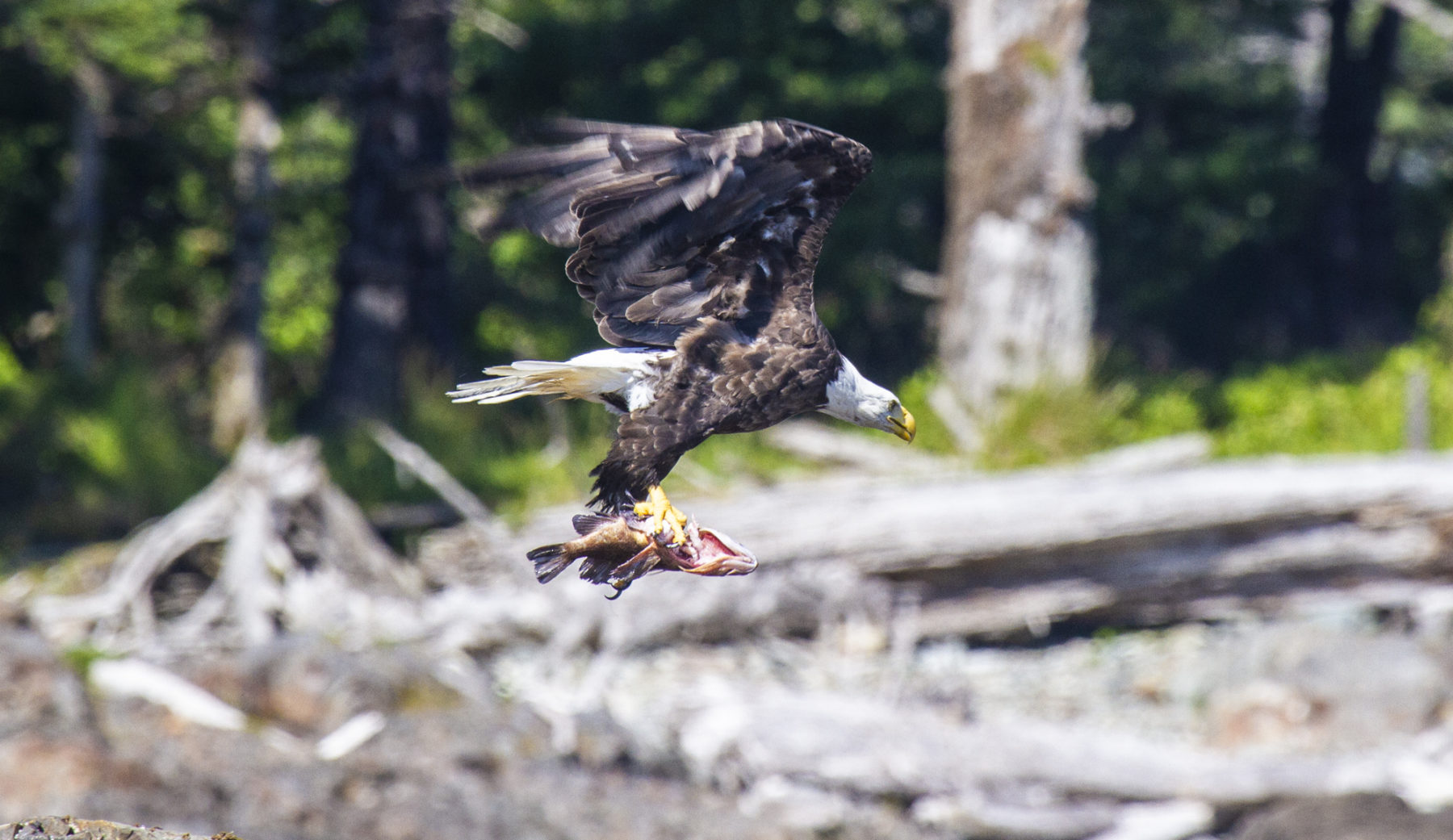
We had a jarring reality check not long after watching the eagles; we’d gotten quite used to being the only people in the islands when we spotted, far in the distance, another group of kayakers. They seemed pretty intent on getting wherever they were going quickly though – we waved but they just ignored us – and Silke and Beth Anne mentioned they might actually beat us to our planned campsite of Iron Point, which would mean, for us, more paddling around to the southern side of Carpenter Bay where our guides had camped before. At 18.5 nautical miles it was to be our longest paddle, but it was great. The varying conditions, from flat water to more exposed and windier on the eastern side of the islands, made for the perfect paddling challenge, which would be topped the following day as we continued south to (hopefully) our main goal of SGang Gwaay.
In the shadow of giants
As we paddled further into the southern section of the islands, I thought just how easy it would be to lose oneself in Haida Gwaii. And I wasn’t even having a problem with the concept of sharing this watery utopia – mainly due to the fact that those I would be sharing with were, er, considerably larger or, in the case of the wind and tides, insurmountable.
It was day four and five that really emphasised just how strong nature’s rule is here. Over the course of these two days, we’d moved a fair distance south, following, firstly, the Moresby Island coastline with its distant views of the mountains of Kunghit Island at our bows. Just off Point Langford, near the Langford Shoals, we’d rafted up to watch four humpbacks feed, around 100 to 150 metres away. It was mesmerising; we stayed there for over an hour as these marine leviathans worked their way around the bay chasing food. From here we moved on to our Raspberry Cove campsite, on Moresby’s southeast coast, while being shadowed by a pair of sea lions and further delayed by watching two fishing bald eagles.

Raspberry Cove itself was surreal. Our campsite was in a sea of green moss and huge trees, just back from the beach, while offshore, the giants of the sea continued to feed and frolic. This enhanced reality continued the next morning when we left early to attempt the Houston Stewart Channel crossing to reach SGgang Gwaay. Our early start got blown out of the water, literally, by the sight of a humpback fishing off Cape Fanny, quite close to our kayaks. It was more than an hour later before Silke cajoled us into leaving the whale. The old adage that time and tide wait for no man proved true; Silke had gone ahead to check the crossing and soon returned with the disappointing news that it was just too rough to attempt. Looking out over the channel we could easily spot the whitecaps growing larger and more numerous and knew that any crossing attempt at this point would be far too taxing – and too dangerous.
The disappointment was soon forgotten, however, when we landed at Fanny Bay for camp. We were all so intent on going through the correct landing and unloading procedure that it took us at least a minute to notice the huge black bear watching us from the top of the beach. It was very big and looked well fed with a shiny black coat of fur, and like every other native resident of these islands, the bear was not in the least concerned with the kayakers that were suddenly doing their best statue impressions. It soon ambled away to the side of the beach and disappeared into the forest. Another group of kayakers was camped on the western side of the beach and one of them told us the bear had been up and down the beach a few times, eating seaweed and shellfish. All I could think was, “I hope he is full.” But even with the large island bear theory confirmed, I still thought I could live here… as long as I had a solid hut with a very strong front door.
A never forgotten world
Our second attempt at heading south to SGang Gwaay was more successful. We left early and were soon welcomed by (what we presumed was) the humpback from yesterday, still fishing off Fanny Point. We were at Louscoome Point soon after and geared up for our southwest crossing of the Houston Stewart Channel, watching the conditions earnestly. It was still flat, with only a bit of wind blowing up from the south resulting in minimal chop. I was seriously pumped; I had been focused on reaching – and exploring – SGgang Gwaay since I had been confirmed on the trip and it was now oh, so close. But I knew that reaching the World Heritage site was not always possible, due to the difficulty of the crossing. When Silke and Beth Anne gave the okay, I shot off at some speed, only to be calmly called back by Silke to paddle with the rest of the group. By sticking close together, we had the best chance of minimising the stalling effects of the headwind, and thus the best chance of actually making it to the island.
It was only when, an hour later, we reached one of the island’s sheltered bays that I relaxed. We’d made it, but it had been tough. The winds and sea had both risen dramatically in that hour, so much so that even the sight of a humpback mother and calf had not been enough to stop us.
SGang Gwaay (or Ninstints as it is also known) was the last village to be occupied by the Haida people on a full-time basis during the first-contact history. The island contains a number of memorial posts and mortuary poles, all of which are carved with the crest of the deceased. There is also a Watchmen’s hut here and, as a rule, people are not permitted to camp here.

James Willian, a Haida Watchman, tells us about the mortuary poles on SGgang Gwaay. 
Gary packs his and Sue’s double sea kayak before leaving Fanny Bay for the crossing to SGang Gwaay.
Once we’d landed and secured our kayaks, we made our way through lush forest to the Watchmen’s hut, where James William and some Haida teenagers, who were getting their first experience of the Watchmen program, greeted us. James has spent many years looking after the island and the historical village each season and was a fount of knowledge on the history of the site as he showed us around. Listening to his explanation of the mortuary poles – how they were constructed and how the funeral box containing the remains would sit atop the carved pole – and how the now ruined long houses would have been constructed, was enthralling and provided a great insight to the Haida way of life before the devastation of first contact with Europeans. The arrival of Europeans and diseases such as smallpox decimated the Haida Nation’s population and, as the numbers dwindled, so did the settlements. SGang Gwaay was the last village to be deserted – in 1880 – but, thanks to the dedication of the Haida people of today, visitors can still get a sense of what life was like many hundreds of years before Europeans arrived. It’s a sad story, repeated worldwide, but seeing the pride on James’s face as he recounted the many stories around each memorial pole was all the reassurance needed to know the Haida people and their culture aren’t going anywhere.
A final surprise
Our visit to SGang Gwaay had taken a wee bit longer than we thought (we also did a short exploratory hike to a Haida habitation cave) and in that time, the winds and sea had risen dramatically. After our tour, we were all girding ourselves for the return paddle to Fanny Bay, and then the next day’s paddle to Raspberry Cove for our Zodiac pickup. Even thinking about the end of our adventure was enough to put a dampener on the day. Until, that is, Beth Anne told us we’d been given the rare privilege of permission to camp on the island, rather than risk the return crossing. Being able to actually reach the island had been a great achievement; being allowed to camp here was the new highlight.
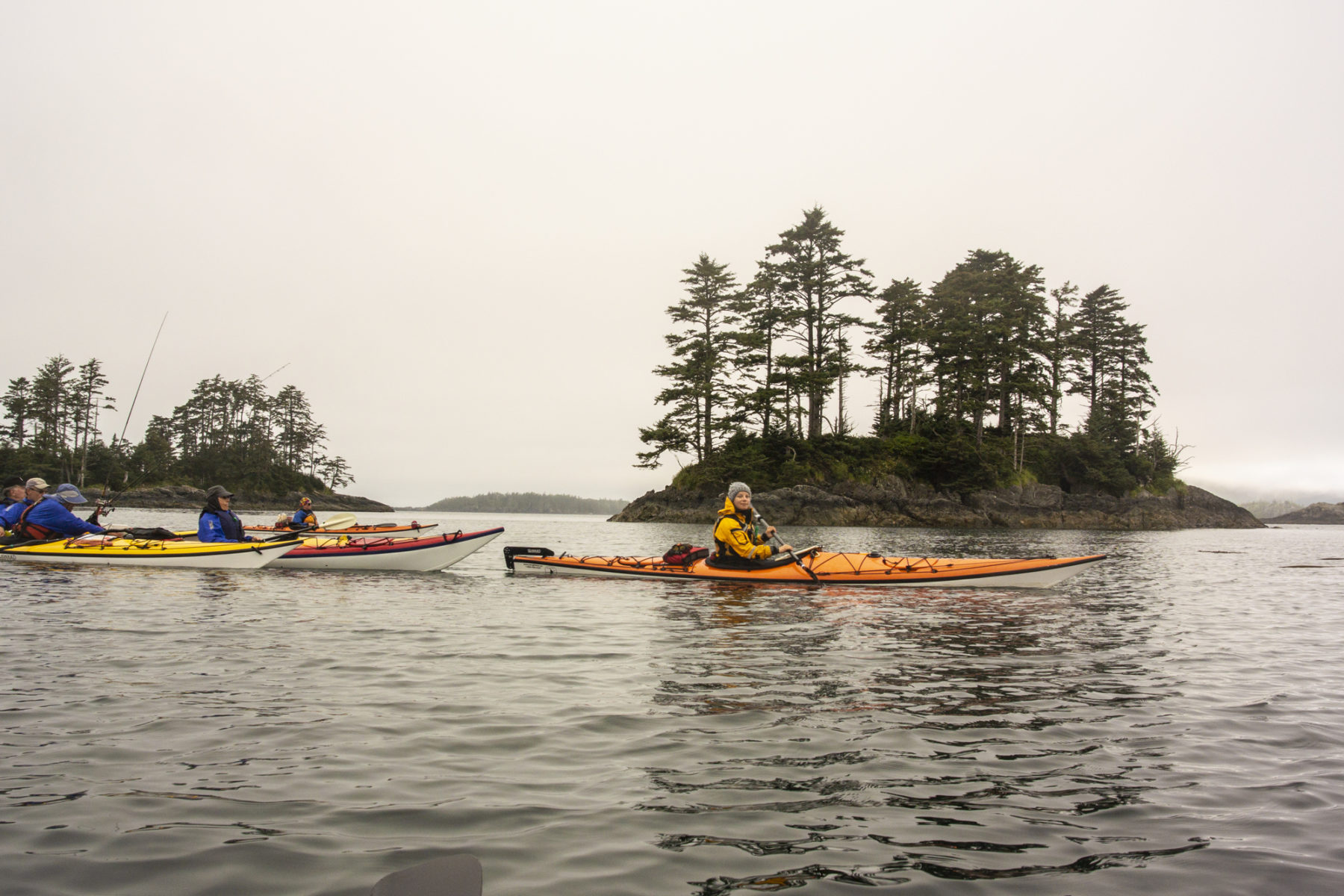
I wrote in my notebook the next morning: “I have just had the best night’s sleep outdoors in my life.” I don’t know whether it was the spiritual ambience of the island itself, or that combined with exhaustion after a big previous day. Either way, it was hard to leave SGang Gwaay behind and point our kayaks towards “home” which, in our case, would be Raspberry Cove. It was another long-ish day, but it did not seem at all tiring. Interspersed with the sites and wonders of more whales feeding was another view of our friend, the rather large black bear. It was up on a high cliff, planted on hits haunches just looking out to sea when we spotted it. I am not sure if we even registered in its mind at all – it was just like us, captivated by the crashing of the waves against the cliff wall.

Later that day we detoured to Rose Harbour, across the other side of the bay from Raspberry Cove campsite, to meet up with an eccentric German gentleman who ran a B&B there, out of the old whaling station. The station itself was interesting, but even more so were the remains of a Haida canoe in the forest about a 10-minute walk from his abode. The canoe had been nearly completed before being abandoned and left for the forest to reclaim. Its moss-covered shape proved that no matter how much humanity alters the land during its tenure, nature always wins in the end.
The return
The last day of any adventure is usually pretty chilled and ours at Raspberry Cove was no exception. Sleeping in was a luxury, as was the copious amount of coffee brewed up by Beth Anne and Silke from our mobile camp kitchen. I also did, for the very last time, the big walk/scramble over rocks and across creeks to our au naturel tidal outhouse, only to find out that there was actually a “proper” outhouse at this campsite, only five minutes from our tents. Apparently Silke and Beth-Anne had forgotten…
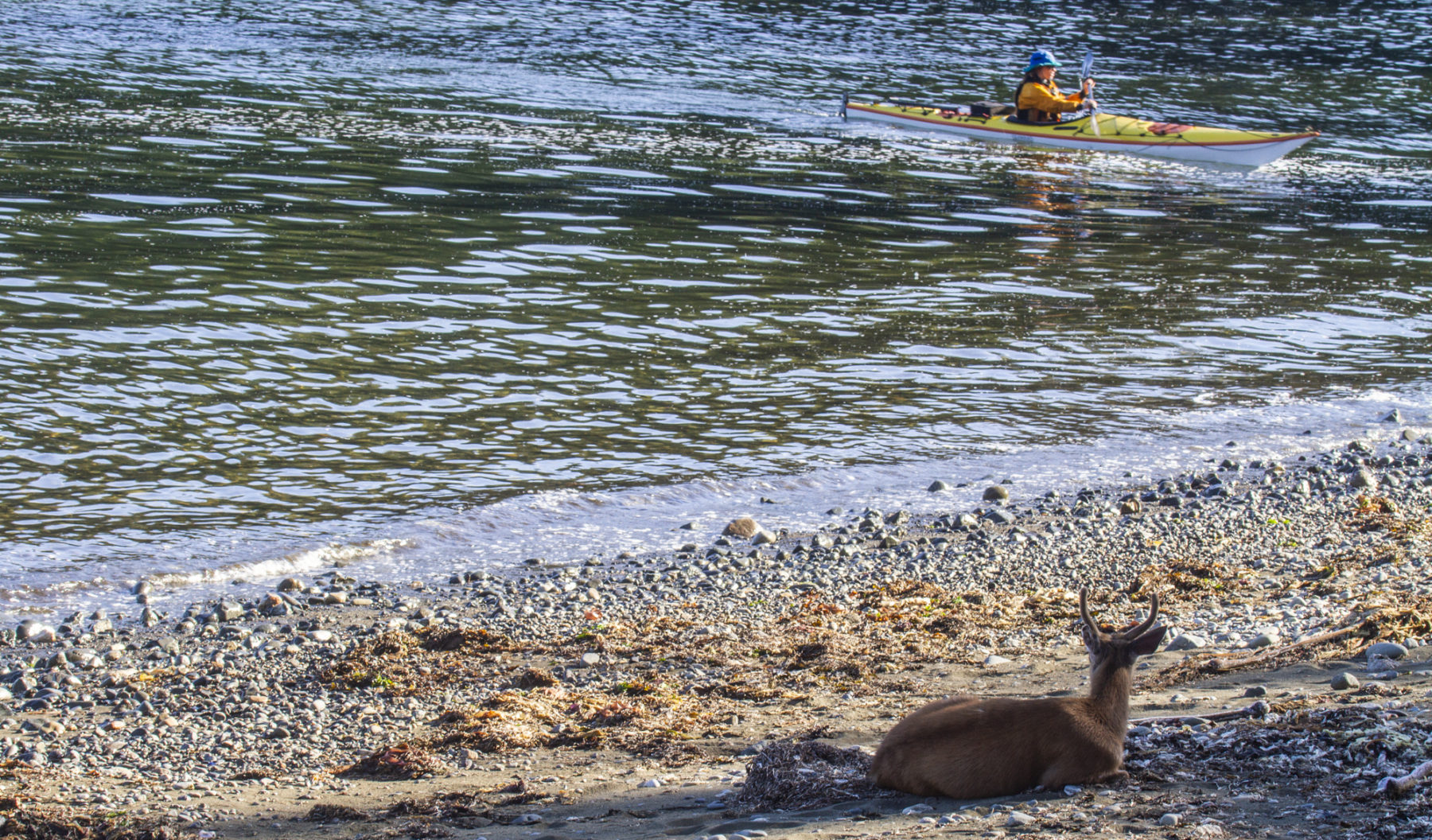
The return Zodiac trip was fast, but not too fast for me not to flick back over the myriad highlights of my eight days in Haida Gwaii. Every day offered more, cementing this expedition as one of my most memorable. Whether it was watching the whales feed right near our kayaks, or laughing at the bald eagle’s mock-dive, each day contained a unique highlight. The most vivid memory, however, was the day and night at SGang Gwaay. Watching whales feed near us as we paddled across to a magical, culturally infused island – and then being allowed to camp there – will forever stay with me when I think of Haida Gwaii.
See Kingfisher Wilderness Adventures for info on this and many more guided kayaking adventures.

